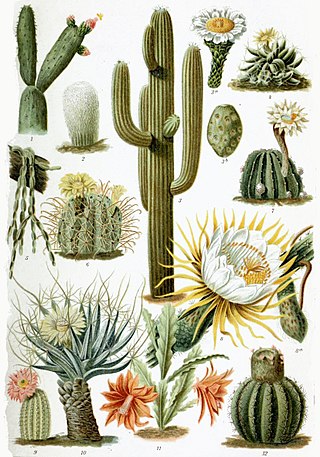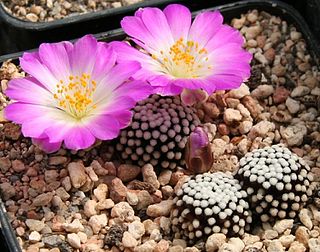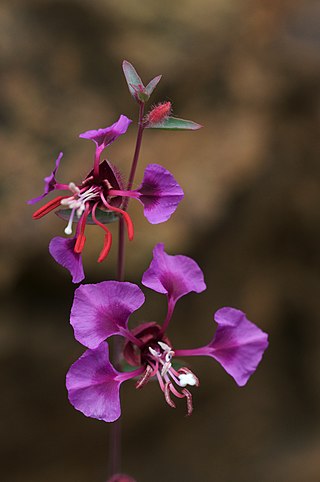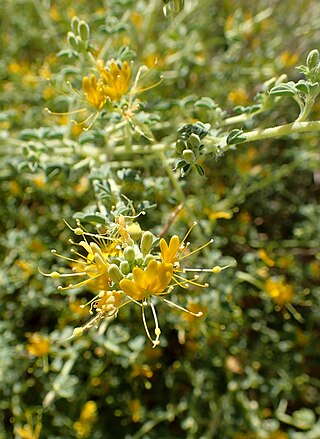
A cactus is a member of the plant family Cactaceae, a family of the order Caryophyllales comprising about 127 genera with some 1,750 known species. The word cactus derives, through Latin, from the Ancient Greek word κάκτος (káktos), a name originally used by Theophrastus for a spiny plant whose identity is now not certain. Cacti occur in a wide range of shapes and sizes. They are native to the Americas, ranging from Patagonia in the south to parts of western Canada in the north, with the exception of Rhipsalis baccifera, which is also found in Africa and Sri Lanka. Cacti are adapted to live in very dry environments, including the Atacama Desert, one of the driest places on Earth. Because of this, cacti show many adaptations to conserve water. For example, almost all cacti are succulents, meaning they have thickened, fleshy parts adapted to store water. Unlike many other succulents, the stem is the only part of most cacti where this vital process takes place. Most species of cacti have lost true leaves, retaining only spines, which are highly modified leaves. As well as defending against herbivores, spines help prevent water loss by reducing air flow close to the cactus and providing some shade. In the absence of true leaves, cacti's enlarged stems carry out photosynthesis.

Lycopodium clavatum is the most widespread species in the genus Lycopodium in the clubmoss family.

Gaillardia pulchella is a North American species of short-lived perennial or annual flowering plants in the sunflower family.

Echinocereus engelmannii, the strawberry hedgehog cactus or Engelmann's hedgehog cactus, is a cactus commonly found in desert areas of the southwestern United States and the adjacent areas of Mexico, including the states of California, Nevada, Utah, Arizona, Baja California and Sonora.

Cochemiea dioica, also called the strawberry cactus, California fishhook cactus, strawberry pincushion or fishhook cactus, is a cactus species of the genus Cochemiea. Its common name in Spanish is biznaga llavina.

Mammillaria luethyi is a species of cactus endemic to the Mexican state of Coahuila. The plants are miniature, shaped like balls and covered with tiny white spines and, throughout the summer, large magenta flowers.

Clarkia unguiculata is a species of wildflower known by the common name elegant clarkia or mountain garland. The plant was named after Captain William Clark who was part of the Lewis and Clark Expedition.

Echinocereus triglochidiatus is a species of hedgehog cactus known by several common names, including kingcup cactus, claret cup cactus, red-flowered hedgehog cactus and Mojave mound cactus. This cactus is native to the southwestern United States and northern Mexico, where it is a resident of varied habitats from low desert to rocky slopes, scrub, and mountain woodland. E. triglochidiatus is the official state cactus of Colorado.

Opuntia humifusa, commonly known as the devil's-tongue, eastern prickly pear or Indian fig, is a cactus of the genus Opuntia present in parts of the eastern United States and northeastern Mexico.

Liatris elegans, known commonly as pinkscale gayfeather, pinkscale blazingstar, and elegant blazingstar, is a species of flowering plant in the family Asteraceae. It is native to the southeastern United States as far west as Texas and Oklahoma.

Cleomella obtusifolia is a species of flowering plant in the cleome family. It is commonly known as Mojave stinkweed, bluntleaf stinkweed or Mojave Cleomella. It grows in alkaline soils in the desert scrub. It is an annual herb producing a rough, hairy stem. The branching stem grows erect when new and then the branches droop to the ground with age, forming a bushy clump or mat. Each leaf is made up of three fleshy oval leaflets. Flowers appear in dense racemes on older stems and solitary in leaf axils on new stems. Each flower has generally four hairy green sepals and four yellow petals grouped together on one side of the involucre. The whiskery yellow stamens protrude up to 1.5 centimeters from the flower. The fruit is a hairy, valved capsule a few millimeters in length. It hangs at the tip of the remaining flower receptacle.

Mammillaria spinosissima, also known as the spiny pincushion cactus, is a species of flowering plant in the cactus family Cactaceae, endemic to the central Mexican states of Guerrero and Morelos, where they grow at elevations of approximately 1,600 to 1,900 metres. The species was described in 1838 by James Forbes, gardener of the Duke of Bedford. Botanist David Hunt collected a specimen in 1971, when he located one near Sierra de Tepoztlan, Mexico.

Brewerimitella ovalis is a species of flowering plant in the saxifrage family known by the common names coastal miterwort and oval-leaf miterwort. It is native to western North America from southwestern British Columbia, including Vancouver Island, to northern California as far south as Marin County. It grows in moist, shady habitat, such as coastal forests and streambanks.

Tidestromia lanuginosa, commonly known as woolly tidestromia, woolly honeysweet, honeysweet, or honeymat in English and as hierba lanuda, hierba ceniza, or espanta vaqueras in Spanish, is a species of plant in the family Amaranthaceae. It is a low growing annual found in the United States, Mexico, and the Dominican Republic.

Pelecyphora sneedii is a rare species of cactus known by the common names Sneed's pincushion cactus and carpet foxtail cactus. It is endemic to the Chihuahuan Desert of the southwestern United States and northwestern Mexico. It is a small, variable cactus with a lengthy taxonomic history, and is often subdivided into a number of subspecies or varieties. It is usually found on steep, rocky habitats, primarily of limestone geology, in desert scrub or coniferous forest. A species of conservation concern, P. sneedii faces threats from poaching, urban encroachment, and wildfires.

Opuntia macrocentra, the long-spined purplish prickly pear or purple pricklypear, is a cactus found in the lower Southwestern United States and Northwestern Mexico. A member of the prickly pear genus, this species of Opuntia is most notable as one of a few cacti that produce a purple pigmentation in the stem. Other common names for this plant include black-spined pricklypear, long-spine prickly pear, purple pricklypear, and redeye prickly pear.

Cochemiea grahamii is a species of cactus also known by the names Arizona fishhook cactus and Graham's nipple cactus.

Mammillaria prolifera, commonly known as the Texas or West Indian nipple-cactus, grape cactus, or hair-covered cactus, is a species of cactus native to North America. Three subspecies are currently recognized: M. prolifera subsp. prolifera, M. prolifera subsp. arachnoidea (Mexico), and M. prolifera subsp. texana. The subspecies differ in overall size, the number and color of the spines, and the shape and color of the flowers. Its round or slightly elongated stems usually form small, dense clusters, and flowers are commonly born alongside fruit. It is one of the most popular and widely grown Mammillaria species.

Ephedra coryi, also known as Cory's joint-fir, is a rare, reed-like gymnosperm native to sandy, semi-arid areas of the North American South and Southwest.

Pyrrhopappus pauciflorus, commonly known as smallflower desert-chicory, Texas false dandelion or Texas dandelion, is a species of flowering plant in the family Asteraceae. It is native to the southern United States and northern Mexico. It is a weedy annual found in prairies, clay soils and disturbed habitats such as fields and sidewalks.























